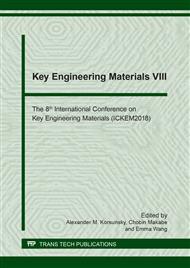[1]
L. Gu, and T. Ozbakkaloglu, Use of recycled plastics in concrete: A critical review, Waste. Manage. 51 (2016) 19–42.
DOI: 10.1016/j.wasman.2016.03.005
Google Scholar
[2]
P. Sikora, E. Horszczaruk, K. Skoczylas, and T. Rucinska, Thermal properties of cement mortars containing waste glass aggregate and nanosilica, Procedia Engineering 196 (2017) 159 – 166.
DOI: 10.1016/j.proeng.2017.07.186
Google Scholar
[3]
A. Cheng, W. T. Lin, and R. Huang, Application of rock wool waste in cement-based composites, Mater. Des. 32 (2011) 636-642.
DOI: 10.1016/j.matdes.2010.08.014
Google Scholar
[4]
Department of Industrial Works, (2558) Information on http://www. diw.go.th.
Google Scholar
[5]
J. Sohaili, S. K. Muniyandi, and S. S. Mohamad, A Review on Printed Circuit Boards Waste Recycling Technologies and Reuse of Recovered Nonmetallic Materials, International Journal of Scientific & Engineering Research 3 (2012) 2229-5518.
Google Scholar
[6]
H. M. Veit, A. M. Bernardes, J Z. Ferreira, J. A. S. Tenorio, and C. F. Malfatti, Recovery of Copper from Printed Circuit Board Scraps by Mechanical Processing and Electrometallurgy, J. Hazard. Mater. 137 (2006) 1704-1709.
DOI: 10.1016/j.jhazmat.2006.05.010
Google Scholar
[7]
J. Li, H. Lu, J. Guo, Z. Xu, And Y. Zhou, Recycle Technology for Recovering Resources and Products from Waste Printed Circuit Boards, Environ. Sci. Technol. 41(6) (2007) 1995-(2000).
DOI: 10.1021/es0618245
Google Scholar
[8]
P. Mou, X. Dong, and D. Guanghong, Products Made from Nonmetallic Materials Reclaimed from Waste Printed Circuit Boards, Tsinghua Science and Technology 12 (2007) 276-283.
DOI: 10.1016/s1007-0214(07)70041-x
Google Scholar
[9]
P. Saengpaeng, P. Kanchanapiya, and C. Tuakta, Properties of Alternative Concrete Mixed with Non-Metallic Powder from Recycled Printed Circuit Boards, in: Proceeding of 62nd IASTEM International Conference (2017) 13-17.
Google Scholar
[10]
ASTM Standard C150. 2011. Standard Specification for Portland Cement. Annual Book of ASTM Standards, American Society for Testing and Materials, West Conshohocken, PA.
Google Scholar
[11]
ASTM International. Standard Specification for Concrete Aggregates; ASTM C33; ASTM International: West Conshohocken, PA, USA, (2013).
Google Scholar
[12]
ASTM International. Standard Test Method for Compressive Strength of Hydraulic Cement Mortars (Using 2-in. or [50-mm] Cube Specimens); ASTM C109M-13; ASTM International: West Conshohocken, PA, USA, (2013).
DOI: 10.1520/c0109_c0109m-13
Google Scholar
[13]
ASTM International. Standard Test Method for Density, Absorption, and Voids in Hardened Concrete; ASTM C642-13; ASTM International: West Conshohocken, PA, USA, (2013).
Google Scholar
[14]
ASTM International. Standard Test Method for Flexural Strength of Concrete (Using Simple Beam with Center-Point Loading); ASTM C293-02; ASTM International: West Conshohocken, PA, USA, (2002).
DOI: 10.1520/c0293_c0293m
Google Scholar
[15]
H.M. Owaida, R. Hamida, S. R. S. Abdullaha, N. T. Koflia, and M. R. Tahaa, Physical and mechanical properties of high performance concrete with alum sludge as partial cement replacement. J. Teknologi (Sciences and Engineering) 65(2) (2013).
Google Scholar
[16]
J. L. R. Herrero, et al, Mechanical and thermal performance of concrete and mortar cellular materials containing plastic waste, Constr Build Mater. 104 (2015) 298-310.
Google Scholar
[17]
N. K. Sharma, P. Kumar, S. Kumar, B. S. Thomas, and R. C. Gupta, Properties of concrete containing polished granite waste as partial substitution of coarse aggregate, Constr. Build. Mater. 151 (2017) 158-163.
DOI: 10.1016/j.conbuildmat.2017.06.081
Google Scholar
[18]
A. Abdullah, S. B. Jamaludin, M. I. Anwar, M. M. Noor, and H. Hussin, Assessment of Physical and Mechanical Properties of Cement Panel Influenced by Treated and Untreated Coconut Fiber Addition, Physics Procedia 22 (2011) 263-269.
DOI: 10.1016/j.phpro.2011.11.042
Google Scholar
[19]
Information on http://www.rockwool.co.uk/products/rockwool-thermal-insulation-slab.
Google Scholar
[20]
M. Akatsuka, and Y. Takezawa, Study of High Thermal Conductive Epoxy Resins Containing Controlled High-Order Structures, J. Applied Polymer Science 89 (2003) 2464 –2467.
DOI: 10.1002/app.12489
Google Scholar
[21]
K. Hannawi, W. Prince, and S. K. Bernard, Effect of thermoplastic aggregates incorporation on physical, mechanical and transfer behavior of cementitious materials, Waste Biomass Valor. 1 (2010) 251–259.
DOI: 10.1007/s12649-010-9021-y
Google Scholar
[22]
S. Akcaozglu, K. Akcaozglu, and C. D. Atis, Thermal conductivity, compressive strength and ultrasonic wave velocity of cementitious composite containing waste PET lightweight aggregate (WPLA), Composites: Part B 45 (2013) 721–726.
DOI: 10.1016/j.compositesb.2012.09.012
Google Scholar
[23]
W. T. Lin, A. Cheng, R. Huang, and S. Y. Zou, Improved microstructure of cement-based composites through the addition of rock wool particles, Mater. Charac. 84 (2013) 1-9.
DOI: 10.1016/j.matchar.2013.06.020
Google Scholar


